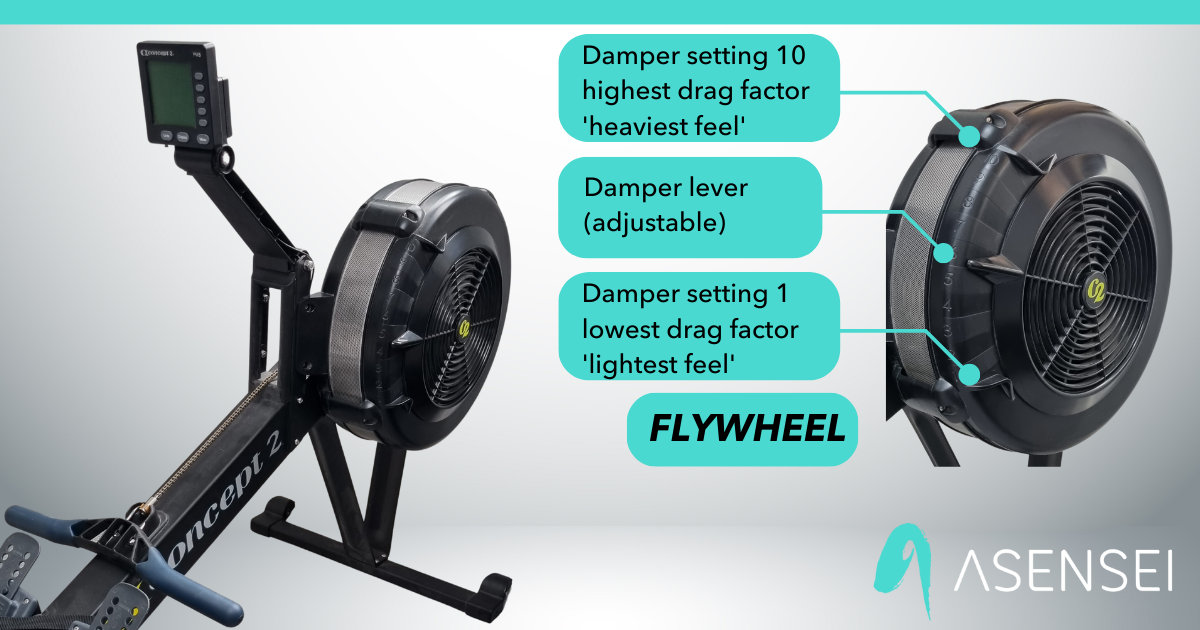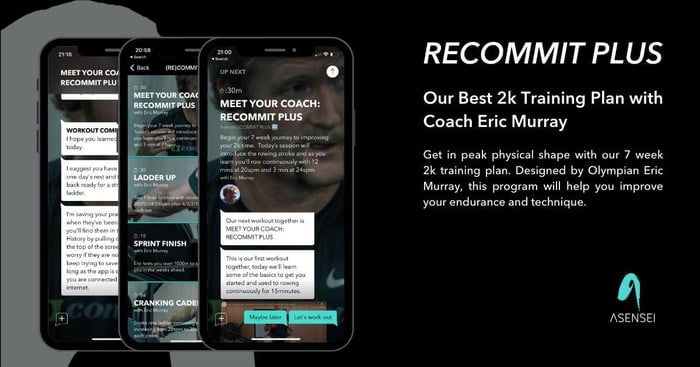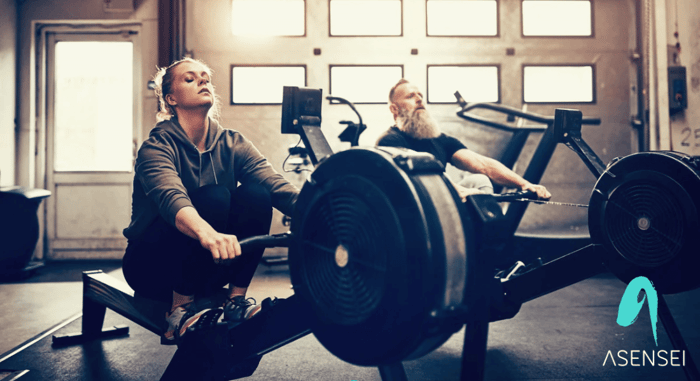Not sure where to set your damper for the best workout on the rowing machine? Heard about drag factor on the Concept 2 RowErg but don't understand why it matters and how it relates to the damper setting?
In this post we take a deeper look into how the erg works to give insight into what the terms damper and drag factor mean, how they affect your workouts; we explain the best damper setting and drag factor for you to use and also give you some workouts that will help put everything you have learned into practice!
Table of Contents
- What is the damper?
- What is the drag factor?
- FAQs
- What's the right drag factor for me?
- Does a higher drag factor make the workout harder?
- What are some reasons to change the drag factor?
- What drag do the best rowers use?
- What does the term drag factor refer to?
- Does a Rogue Echo Rower have a damper and drag factor setting like Concept 2?
- Where can I learn more about drag factor?
- Drag factor Concept 2 workouts
- Conclusion
- Download and try asensei for free
What is the damper?
The damper is the device on the flywheel cover that controls how much air flows around the flywheel. Use the lever on the damper to open or close it.
What is the damper setting?
The damper can be set to a maximum of 10 (fully open) and a minimum of 1 (fully closed).
The higher the damper number, the more open the damper, which gives the flywheel more air. During the recovery phase of the rowing stroke, the more air the flywheel has, the faster the flywheel slows down.
The lower the damper number, the less open the damper, which gives the flywheel less air. During the recovery phase of the rowing stroke, the less air the flywheel has, the less it slows down.
Why is the damper adjustable?
The damper gives rowers a choice in what the drive phase of the rowing stroke feels like.
It's important to note that the damper doesn't control the amount of work you do during the rowing stroke. Relatedly, the damper doesn't control the intensity of the workout.

Drag Factor Concept 2: illustrating the damper lever and the relationship with drag factor and 'feel'
What is the drag factor?
During the recovery phase of the rowing stroke, the monitor measures how much the flywheel slows down before you take the next stroke. The rate of deceleration of the flywheel is called the drag factor.
Using the measurements of the drag factor on the Concept 2 and the moment of inertia of the flywheel, the monitor calculates the watts, pace, and calories we use for each stroke.
What's the relationship of damper setting to drag factor?
The damper is the primary way to control the drag factor: the more open the damper, the higher the drag factor. A new RowErg has a drag factor of about 90 at a damper setting of 1, and a drag factor of about 210 at a damper setting of 10.
Because the damper controls the airflow, the damper is related to the drag factor, even though they aren't calibrated together in a predefined relationship. For example, a new RowErg might have a drag factor of 100 on a damper setting of 2, but one year later, the same RowErg might have a drag factor of 95 on a damper setting of 2 if the flywheel is a bit dusty.
And while it's not a predefined relationship, it is true that as the damper setting increases or decreases, so does the drag factor on Concept 2.
| Damper Setting | Drag Factor | Flywheel resistance |
|---|---|---|
| Damper Lever at 1 | Lowest value (around 90 for a new rowing machine) | lowest resistance, rowing stroke feels ‘lightest’ |
| Damper Lever at 10 | Highest value (around 210 for a new rowing machine) | highest resistance, rowing stroke feels ‘heaviest’. |
Drag Factor Concept 2: table summarizing damper setting, drag factor values & 'feel' of rowing stroke
What affects the drag factor besides the damper?
Over time the Concept 2 drag factor values will decrease if the rowing machine is used in a dusty environment and the dust builds up inside the flywheel cover.
Temperature and elevation also change the drag factor values on a machine: higher temperatures and higher elevation will both decrease the drag factor.
It's a great idea to keep your Concept 2 in top shape, including cleaning out the flywheel - find out how in 5 tips for Concept 2 Maintenance.
Why is the drag factor useful?
The drag factor is a precise measurement that enables you to have a similar rowing experience on different Concept 2 RowErgs in different environmental conditions. Although the same damper setting on different machines does not result in the same drag factor, the same drag factor on different machines should feel similar, if not exactly the same.
How do I set the drag factor?
To set the drag factor on the latest Concept2 Performance Monitor (the PM5):
- From the main menu, press More Options.
- Press Display Drag Factor. The monitor reads, "Row to display Drag Factor".
- Row several strokes at the same stroke rate and pace that you will row for your workout. The drag factor Concept 2 value will be displayed on screen.
- If you wish to adjust the drag factor value then adjust the lever higher or lower and row several more strokes. Repeat until you achieve your target Drag Factor value.
FAQs
What's the right drag factor for me?
When first learning to row, set the lever on the damper to somewhere in the middle, with a setting of 3-5 being recommended by Concept2. That damper setting should result in a drag factor of around 100-140, depending on conditions.
A wide range of drag factors can work well, though you might develop a more narrow range that you prefer to use for short, medium, or long distance workouts.
Drag factor is more about personal preference and training goals, and less about right and wrong. Which drag we use depends mostly on our technique and how heavy we like the load to feel.
Other than preference, the only thing that really matters regarding drag factor is that we don’t hurt ourselves. A heavier drag is sometimes preferred by very strong people, and it can be fine, except that over many workouts, a heavy drag tends to be harder on the lower back.
Does a higher drag factor make the workout harder?
No, you can have an easy intensity workout with a high drag factor, or a high intensity workout with a low drag factor. Intensity comes down to how hard we work over time.
With that said, a higher drag can feel heavier on the drive than a lower drag because the flywheel slows down more quickly when drag is higher. When the drag is lower, the flywheel doesn't slow down as much, so it feels lighter. With a lower drag, we must apply the force quickly to accelerate the flywheel faster than it is already moving.
A fast-moving flywheel can be particularly difficult to feel at the catch position, especially when first learning to row. It takes patience and experience to learn to feel the connection on the feet. You can read more about the catch at Coaching gold: the essence of the indoor rowing catch, where you can also watch some helpful video explanations from Coach Eric Murray.
What are some reasons to change the drag factor?
You could row every workout at the recommended damper setting of 3-5, no matter how short or long the workout, and no matter the intensity.
But if you like to experiment, you can try lower or higher drag factors and see how it affects your performance and feel. The classic question on-water rowers ask themselves is, Will it make the boat go faster?, and it's a good one to keep in mind (for indoor rowers the equivalent question is will it make my time faster?). Because no matter what setting you choose, it's hard to argue with speed and what works for you.
Some reasons to change the drag factor Concept 2 might be:
Working on technique. Experimenting with lower or higher drag factors can help us build body awareness for improved technique.
Specific workout goals. For example, when doing very short sprint intervals of 100 meters or one minute, a high drag is sometimes used to help maximize the pace.
Recovery. If you are recovering from an injury or hard workout, a low drag factor can help keep the training load as light as possible.
What drag do the best rowers use?
While the best rowers tend to use a high drag factor only for specific types of workouts, it does vary, as reported in The Damper and Drag of Olympians. In the article, several rowers explain why they chose their drag factor Concept 2 numbers, including asensei coach Eric Murray, who began using 130 when training for the New Zealand national team.
In general, on-water rowers train indoors with a drag that's not too far from the one they experience in the boat. In winter training, at least some coaches prefer that their rowers use lower drag factors on ergs to help preserve technique that moves boats, not ergs.
A single racing shell on water has an equivalent erg drag factor of roughly 130.
A fast-moving eight-person racing shell has a much lower erg drag equivalent, something more like 90. One workout at 90 drag factor can give real insight into what it takes to row in the fastest Olympic boat class.
What does the term drag factor refer to?
Drag is a term that applies to how quickly the flywheel slows down on a Concept2 erg, but it's also applicable to rowing in a boat on the water. On the water, drag means essentially the same thing as it does on the erg: how quickly the boat slows down from fluid drag of the water against the hull. Drag factor is a way to consistently set the 'feel' of your row across Concept 2 indoor rowing machines.
With good technique, a fast boat like a racing shell feels almost light to row compared to a heavy traditional row boat that doesn't have much run between strokes.
Though all rowing boats are similar in that they face backwards and use oars to propel them through the water, the difference in specifications between types of rowing boats can be quite vast:
A typical single racing shell is roughly 8m (26ft) long, 28cm (11in) wide, with a weight of 14kg (30lbs).
Even a modern, newly built rowboat can be nearly half as long as a racing shell, but can be five times as wide and weigh 10 times as much, resulting in a higher drag that feels heavier.
Does a Rogue Echo Rower have a damper and drag factor setting like Concept 2?
The Rogue Echo Rower has been designed for compatibility with the Concept 2 RowErg, and this extends to a similar damper lever on the side and drag factor mechanism. As an air resistance rowing machine you can control the 'weight' of the resistance through the damper lever. Indeed the Rogue Rower is certified to use in Crossfit competitions as well as the Concept 2 machines, which gives a good indication that they are extremely similar.
Where can I learn more about drag factor?
Drag Factor Concept2, Damper Setting 101
CrossFit Journal, Getting the Most from the C2 Rower, Part 3 by Peter Dreissigacker (co-founder of Concept 2)
Physics of Rowing, The Physics of Ergometers by Anu Dudhia
Drag factor Concept 2 workouts
If you'd like some guidance from a coach, asensei have a number of great workouts on YouTube where double Olympic Champion and asensei coach Eric Murray talks us through various combinations of intervals, rates, and drags to help us find what's comfortable for us.
NATURAL POWER
Learn to increase your rowing power and speed without increasing the stroke rate. To achieve more speed without an increased stroke rate, Eric guides you through the workout to squeeze slightly higher intensity from the drive while controlling the recovery.
Workout Structure
- Introduction and workout explanation
- Warmup
- Workout - 6x5min with 60s rest
- 5min at 20spm (steady pace)
- 3/2min at 20/22spm (increase pace every min)
- 5min at 22spm (increase pace every min)
- 5min at 22spm (increase pace every min)
- 2/3 at 22/24spm (increase pace every min)
- TBC (increase pace every min)
- Cooldown and debrief
- Question & Answer
DRAG PLAY
Find a drag factor that works for you by varying the damper setting on your rowing machine for several sets. Eric talks you through what to look for as you experiment.
Workout Structure
- Introduction
- Warmup
- Session Goals and Erg Setup
- Workout - 5 x 6min 60s rest
- 6 min at 20spm - normal drag factor Concept 2
- 3/3min @20/22spm, drag up a bit
- 3/3min @22/24spm, drag up a bit more
- 6min @22spm, drag your choice
- 3/2/1min @22/24/26spm, drag your choice
- Cooldown
- Recap
PUMP THE POWER
Vary the drag factor to help develop power in the rowing stroke. During the sets, we will increase the stroke rates as we increase the drag factor. For the last set, we will return to the initial drag factor with increased stroke rates, and you will feel the difference.
Workout Structure
- Introduction
- Warmup
- Session Goals and Erg Setup
- Workout - 6x4min 1min30s rest
- 2,2min @ 20,22spm normal Drag Factor (DF)
- 2,2min @ 22,24spm +15DF (+1 space)
- 2,2min @ 22,24spm +30DF
- 2,2min @ 24,26spm +30DF (no change in DF)
- 2,1,1min @ 24,26,28spm +30DF (no change)
- 1,1,1,1min @ 24,26,28,30spm (normal DF)
- Cooldown
- Recap
- Q&A
You can also find the PUMP THE POWER and DRAG PLAY workouts and many more in the asensei app as part of the RECOMMIT+ program. In the app you will also benefit from structured + personalized training programs, custom target split times for your rowing and much more.
POWER STROKE / DRAG EXPERIMENT
Keeping the stroke rate consistent but changing the drag factor slightly over many short intervals can help you understand which drag works best for you over the course of a workout.
Workout Structure
- Warmup
- 19 sets of 60s rowing at 22spm with 20s rest in between. Change the damper setting on each set.
- Start with damper lever at 5 and increase by 1 in each set until at setting 10
- Reduce damper setting by 1 in each set - 9 down to 1
- Increase damper setting by 1 each set - 2 up to 5
- Cooldown and debrief
- Question and Answer session
Conclusion
Although drag factor matters, it's not something to be overly concerned about, especially when first learning to row. You can get a good workout by using a wide range of drag factors and damper settings. Some excellent rowers don't understand the finer points of drag factor and damper setting for years, if ever - finding what works for you is the key point!
With a little trial and error during your workouts, you will find a comfortable range of drag factors that you prefer for different situations. And, as your fitness, technique, and experience increase, you might feel the need to make a temporary or permanent change to your drag factor, depending on your goals.
Thank you to Jon Williams, longtime Concept2 engineer (retired), for taking the time and effort to review this article. His valuable comments and suggestions helped improve the quality of the article. The rowing community is lucky to have a generous subject matter expert who is still sharing his knowledge, years after his official retirement in 2018.
Download and try asensei for free
ASENSEI is FREE to download and with no commitment you can trial the first 3 workouts in the (RE)COMMIT program and also workouts from MASTER THE BASICS, (RE)FOCUS, SWEAT FACTORY and BE A DARK HORSE. All you need is an iPhone and access to an asensei Compatible rowing machine from Concept 2, WaterRower or FluidRower with a Bluetooth capable monitor |





